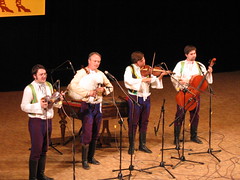Three Men and a Bagpipe
Kašava is from a region in north Moravia called Valašsko (Walachia, with various spellings, in English and German). Valašsko has a bagpipe tradition. The picture is a group from the "Croatian minority" (descendants of Croatians who settled in south Moravia) in the Czech Republic. They use bagpipes, too.
As I suppose is the case everywhere, there are a lot of jokes about the bagpipe. I started realizing the basic Czech bagpipe joke a while back when I saw A Prarie Home Companion (the movie). At one point Lefty the cowboy makes a joke like this:
[Taking a swig of whiskey from his hip flask, he addresses a beautiful lady haunting the theater's backstage]:
Hey, I'll give you some moonshine if you show me your jugs.
I'm assuming this doesn't need explanation (if you keep reading it will dawn on you eventually). Well, the Czech subtitles said something like this: I'll sing you a song if you let me play your bagpipes. My response was, "What? They completely got the wrong metaphor." To me it seemed obvious that "playing the bagpipe" must refer to male anatomy. But not in Czech! It refers to the female, the above-mentioned "jugs" (just to be clear and slightly obfuscatory at the same time).
What, you are probably thinking, does this have to do with the folk music festival? Good question. Kašava and two other groups featured bagpipe numbers, which were played by the traditional bagpipe ensemble—bagpipes (the player doubles as singer), violin, viola, and occasionally cello (bassette or even double bass sometimes). So you have a basically complete, portable ensemble for singing songs and accompanying dances. This sort of group was common in many parts of central Europe, and in the Czech Republic, there are still groups in Moravia and south Bohemia.
This morning I was talking with my cimbalom teacher, who is recording a new album that will feature bagpipes, and I told him about the concert at the folk instrument festival:
"So I went to this concert last weekend, and this group played the bagpipes."
"Uh huh."
"There was one bagpipe and three men."
Laughter.
I'll leave the details to your imagination. It took me a while actually, due to my various linguistic slownesses, to get it. But finally, it dawned on me: to Czechs—just so you know, the "bagpipes" seem to be the primary focus of erotic attention here—to Czechs, one set of bagpipes is not enough for three unless you're making a *ahem* movie or on videochat.
Just one of those moments when you think you're just talking about folk music and it turns out a little differently than you expected.
Tags: music, language, czech, moravia, bagpipes

 A graduate student in music and anthropology writing a dissertation about music in Moravia, the eastern third of the Czech Republic. At some point, the Czech Republic's "second city" (that would be Brno) captured my attention, and I've since been blogging about events, arts, music, and other stuff—basically whatever interests me in and around the cityscape. I'm not living in Brno now, but I keep up with the cultural pulse from afar as best I can.
A graduate student in music and anthropology writing a dissertation about music in Moravia, the eastern third of the Czech Republic. At some point, the Czech Republic's "second city" (that would be Brno) captured my attention, and I've since been blogging about events, arts, music, and other stuff—basically whatever interests me in and around the cityscape. I'm not living in Brno now, but I keep up with the cultural pulse from afar as best I can.


Comments:
Well, that was unexpected. Perhaps I should avoid talking about bagpipes in Czech.
8:02 PM, October 15, 2006
» Post a Comment